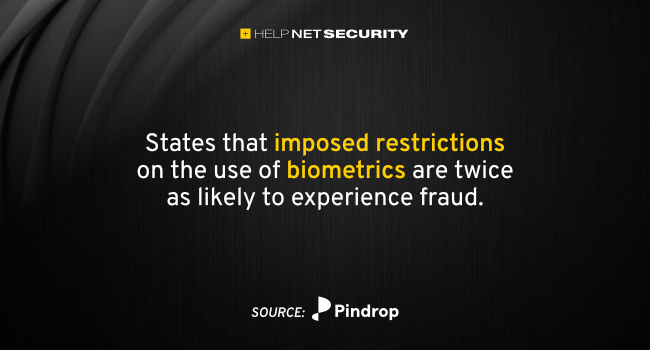Pre-pandemic techniques are fueling record fraud rates
Within the largest financial institutions, insurers, and retailers, the rise and adoption of AI, an impending recession, and the return of pre-pandemic fraud techniques are driving record rates of fraud attacks for consumers and enterprises alike, according to Pindrop.

Researchers have found:
- States that imposed restrictions on the use of biometrics are twice as likely to experience fraud
- In times of financial uncertainty, fraud increases. Financial institutions experienced a 53 percent year over year increase in fraudulent activity in Q4 2022
- With data breaches reaching record levels, fraudsters are leveraging data from the dark web and testing it in the interactive voice response (IVR) to identify high-value accounts and attacking those accounts jointly with other fraudsters
- Retail has emerged as one of the most fraud-dense verticals – one in every 347 calls is fraudulent within call centers supporting online retailers
“Today’s fraudsters are more equipped and creative than ever, using deepfakes, the regulatory landscape, and self service channels to help them successfully attack consumers and corporations,” said Vijay Balasubramanian, CEO of Pindrop.
“In addition to new technologies, fraudsters are reverting to pre-pandemic social engineering tricks, causing retailers and financial institutions billions in losses. While this report highlights the dangers of today’s fraud landscape, we are proud to partner with several of the largest financial institutions globally in order to safeguard their assets and protect them from fraud,” Balasubramanian continued.
The effects of new privacy laws on fraud prevention
Laws regulating personal information have been enacted in the US at state levels. While these privacy laws aim to ensure the safety and privacy of consumers, fraudsters are capitalizing on the unintended consequences of the real-world application of these laws.
Pindrop found that fraud rates in states that pose enhanced restrictions on the use of biometrics (such as California, Texas, and Illinois) are twice as likely to experience fraud. These states also contribute to 33 percent of all fraud losses reported in the US.
The human voice remains a vital factor that can be leveraged for fraud detection. However, as more states consider bills regulating voice without notable security or fraud-prevention exemptions, companies will find their current detection mechanisms are falling short while fraudsters are taking advantage of these laws as the weakest link.
The impact of financial uncertainty on fraud
Data shows that fraud skyrockets during times of economic uncertainty. During the 1980, 1990, and 2008 recessions, fraud offenses increased between 5 and 10 percent.
One in every 784 call center interactions within the financial sector were fraudulent in Q4 2022 – a 53 percent increase from 2021. Additionally, fraud rates in credit unions increased by more than 70 percent in 2022.
Fraud feeding frenzies
Data compromises are at an all time high with more than 1,800 events reported in 2021 and 2022 individually. A combination of the rise of artificial intelligence, the digital economy and the dark web have ushered in an era of large-scale data breaches, where fraudsters are easily obtaining social security numbers (SSNs), birth dates, addresses, email addresses, credit card details and phone numbers as well as medical records and bank details.
Fraudsters are now deploying large-scale vishing and smishing efforts, victim social engineering, and IVR reconnaissance resulting in companies losing billions of dollars and consumer trust. Since 2020, an average of 300 million victims have been affected by these data breaches.
Telecom carriers who have been previously impacted by data breaches experience a 274 percent higher fraud rate compared to other carriers.
The impact of these data breaches in combination with the frequency at which they’re occurring has led to a major security risk for contact centers. Following a data breach, there is a feeding frenzy in the IVR as fraudsters and bots attack customer accounts with the acquired data.
There is a race to perform reconnaissance as fraudsters start figuring out which accounts have the highest monetization potential and teaming up to exploit those accounts. This creates a complex, interconnected web of fraudster activity that makes the IVR ten times more risky than the agent leg.
Retail fraud on the rise
While fraud is most notorious in sectors like banking and insurance, Pindrop’s data found that retail is the most fraud-dense vertical. Fraudsters are attacking retailers through all channels: contact centers, ecommerce, and through credit card fraud.
Recent data found that 3.6 percent of all ecommerce revenue in 2022 has been stolen by fraudsters, and payment fraud grew 40 percent from 2021 to 2022. At the contact center level (where one in every 347 calls is fraudulent), fraudsters are turning to return or concessions abuse in order to receive refunds on purchases still in their possession.